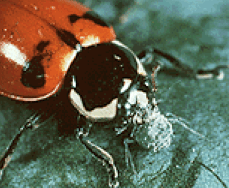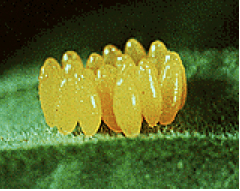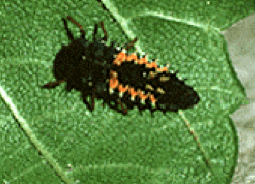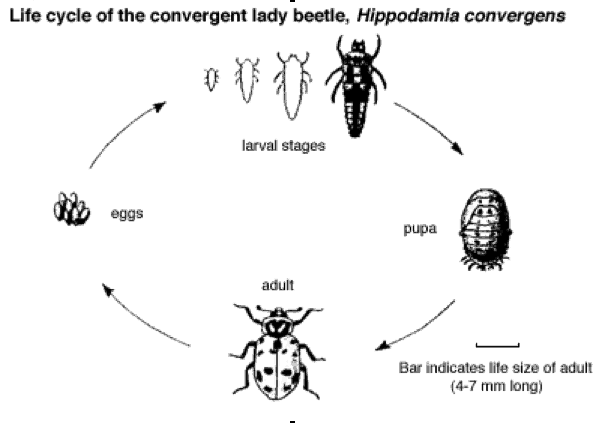Need lady beetle/ lady bug control help on your property?
Training Guide for Lady Beetles/ Lady bugs in Homes & Appartments
Lady beetles, ladybugs, or ladybird beetles are among the most visible and best known beneficial predatory insects. Over 450 species are found in North America. Some are native and some have been introduced from other countries.
Most lady beetles in North America are beneficial as both adults and larvae, feeding primarily on aphids. They also feed on mites, small insects, and insect eggs. The two exceptions are the introduced Mexican bean beetle, Epilachna varivestis, and the squash beetle, Epilachna borealis. The adults and larvae of both species feed on plants.
Appearance
Lady beetles are usually red or orange with black markings. Some lady beetles are black, often with red markings. They have alligator-like larvae.

Habitat (Crops)
Many crops benefit from lady beetles. They are helpful for growers of vegetables, grain crops, legumes, strawberries, and tree crops; however any crop that is attacked by aphids will benefit from these beetles.
Adult Hippodamia parenthesis feeding on a cabbage aphid.

Lady beetle eggs.

Fully grown larva of Harmonia axyridis.
Lady bugs or lady bird beetles are beneficial insects and can become a nuisance in the home or place of business. If you notice a few lady bugs in a home, recommend leaving them alone or pick them up and place them outside. If desired to rid them inside your home, you can always purchase non-toxic sticky traps at your local hardware store to place in your home where needed.
Our technicians will treat your residence in the most eco-friendly manner possible to keep your family and our environment safe. Our technician will start with a visual inspection and monitoring process to identify the species and find the harborage areas. After discovering where the roaches are located, the technician will treat with baits and/or EPA approved products to eliminate the infestation. As we all know, roaches do not always die easy, so our technician will schedule a follow-up visit to ensure the job is complete to your satisfaction.
Most lady beetles found on crops and in gardens are aphid predators. Some species prefer only certain aphid species while others will attack many aphid species on a variety of crops. Some prefer mite or scale species. If aphids are scarce, lady beetle adults and larvae may feed on the eggs of moths and beetles, and mites, thrips, and other small insects, as well as pollen and nectar. They may also be cannibalistic. Because of their ability to survive on other prey when aphids are in short supply, lady beetles are particularly valuable natural enemies.
Adult lady beetles are small, round to oval, and dome-shaped. The most well known have black markings on red, orange, or yellow forewings, but some are black. The area immediately behind the head, the pronotum, may also have a distinctive pattern. The color and pattern of markings for each species may vary, but can aid identification.
Lady beetles overwinter as adults, often in aggregations along hedgerows, beneath leaf litter, under rocks and bark, and in other protected places including buildings. In spring, the adults disperse in search of prey and suitable egg laying sites. This dispersal trait, especially strong in migratory species such as the commercially available convergent lady beetle, can affect the reliability of control by released adult beetles.

Female lady beetles may lay from 20 to more than 1,000 eggs over a one to three month period, commencing in spring or early summer. Eggs are usually deposited near prey such as aphids, often in small clusters in protected sites on leaves and stems. The eggs of many lady beetle species are small (about 1 mm; 1/25″), cream, yellow, or orange, and spindle-shaped. They resemble those of Mexican bean beetle and Colorado potato beetle, but are usually smaller.
Lady beetle larvae are dark and alligator-like with three pairs of prominent legs. Depending on the species and availability of prey, larvae grow from less than 1 mm (1/25″) to about 1 cm (3/8″) in length, typically through four larval instars, over a 20 to 30 day period. Large larvae may travel up to 12 m (about 40′) in search of prey. The larvae of many species are gray or black with yellow or orange bands or spots.
The last larval instar remains relatively inactive before attaching itself by the abdomen to a leaf or other surface to pupate. Pupae may be dark or yellow-orange. The pupal stage may last from three to 12 days depending on the temperature and species. The adults emerge, mate, and search for prey or prepare for hibernation, depending on the availability of prey and time of year. Adults may live for a few months to over a year. The more common species typically have one to two generations per year.
Relative Effectiveness
Lady beetles are voracious feeders and may be numerous where prey are plentiful and broad-spectrum insecticide use is limited. Lady beetles need to eat many aphids per day so that they can lay eggs. The convergent lady beetle may eat its weight in aphids every day as a larva and consume as many as 50 aphids per day as an adult. Seven spotted lady beetle adults may consume several hundred aphids per day and each larva eats 200 to 300 aphids as it grows. Once the adults and larvae have eliminated an aphid colony, they will search for additional food.
Lady beetles are effective predators if aphids are abundant (high pest density) but are thought to be less effective at low pest densities. There may also be some crop damage before lady beetles have an impact on an aphid population. Most lady beetle species are active from late spring to early fall if food is available. The adults of some species, such as Coleomegilla, may be attacked by a parasitoid wasp. Affected beetles are lethargic and may appear to be “attached” to a surface by loose silken threads.
Pesticide Susceptibility
Lady beetles may be tolerant of some chemical insecticides applied at recommended field rates. But tolerance may be influenced by prior exposure of the natural enemy population to the chemical, and there is considerable variation. For example, Coleomegilla maculata has been shown to be susceptible to carbaryl and methamidophos at doses that might be used to control aphids in potatoes. Overwintering adults may be less susceptible to chemical insecticides than active adults and larvae.
Conservation
Lady beetles are mobile as adults and reasonably so as larvae, and they are generalists. They will not remain on a plant, or in the vicinity, once the readily accessible prey has been consumed.
Some species, in particular Coleomegilla maculata, consume pollen as an important part of their adult diet. A source of nectar and pollen, or an artificial substitute, in the vicinity of the crop may attract adult beetles and may reduce dispersal of this and other lady beetle species. Lady beetle adults also benefit from high humidity and nearby shelter, for protection from adverse weather and to provide overwintering sites.
Early season populations of some lady beetles may develop on aphid-infested perennials or shrubs. Collection and redistribution of lady beetles is effective but time consuming. The beetles should be handled gently and placed in groups at the base of plants, rather than broadcast. Hibernating adults, congregating in protected spaces, should not be disturbed as they are vulnerable to attack by predators and parasitoids if uncovered.
Commercial Availability
Field-collected convergent lady beetles are commercially available for use against crop pests, specifically aphids.
130+ Reviews, avg 4.7 stars
Get A Quote Today
When you contact us for an estimate, our certified technicians will inspect your home and provide you with a detailed plan to eliminate those unwanted invaders. They will also discuss treatment options to ensure you are informed before they take any action.
Call our staff today at 425-398-7365. We will provide you with peace of mind, valuable information, and affordable service. We’ll get back to you within 1 business day.




